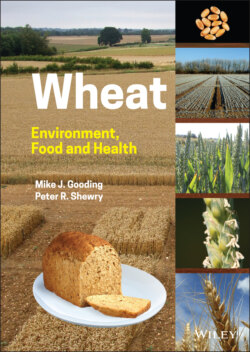Читать книгу Wheat - Peter R. Shewry - Страница 29
1.3.4 The Spread of Wheat Cultivation
ОглавлениеThe cultivation of bread wheat spread via Anatolia to Greece, and then both northwards through the Balkans to the Danube (7000 BP), and westwards to Italy, France, and Spain (7000 BP), reaching the UK and Scandinavia by about 5000 BP. Similarly, wheat spread via Iran into central Asia, reaching China by about 3000 BP, and to Africa, initially via Egypt. It was introduced by the Spanish to Mexico in 1529 CE and by the British to Australia in 1788 CE. These migration routes have been described in detail by Feldman (2001).
This wide geographic expansion of wheat was undoubtedly facilitated by the allohexaploidy of T. aestivum . The environmental and geographic distributions of allopolyploids are often wider than for their diploid parents (Miller 1987). Furthermore, T. aestivum has adapted to a wider range of environments than the tetraploid T. turgidum (Dubcovsky and Dvorak 2007). Feldman and Levy (2005) list several mechanisms by which allopolyploidy has led to the rapid evolution of wheat genomes and gene expression. The multiple genomes would be expected to confer fixed hybrid vigour, genetic buffering, and evolutionary adaptability (Simmonds and Smartt 1999). Having multiple copies of similar genes means that mutations in one or two copies can occur without catastrophic effects. This can, for example, allow the development of intermediate types and better fine tuning of growth and development patterns to the environment. The addition of the D genome appears to have been particularly important given the different and wider geographic distribution and environmental adaptation of Ae. taushcii compared with the wild donors of the A and B genomes. Modern wild stands of Ae. taushcii extend beyond the Mediterranean zones into continental climates (Zohary et al. 1969).
Although T. aestivum is one of the youngest major crop species, it is now also one of the most diverse. Feldman (2001) estimated that about 25 000 genotypes were available globally at the turn of the millennium, but this is clearly an underestimate as material present in countries such as China was not readily available at the time of publication. Although several genotypes of Ae. tauschii contributed to the formation of hexaploid bread wheat, most of the diversity in bread wheat has clearly arisen since the initial hydridisation occurred. Dubcovsky and Dvorak (2007) suggest that this has several origins. Firstly, extensive gene flow has occurred between bread wheat and cultivated and wild forms of tetraploid wheat, particularly wild emmer (He et al. 2019; Allen et al. 2021), capturing diversity from these species. However, gene flow into the D genome has been more limited; it remains less diverse than the A and B genomes (Allen et al. 2021). Secondly, bread wheat has an unusually large genome, comprising about 17Gb of DNA, (about 40 times the size of the rice genome). About 85% of the genome is non‐coding repetitive DNA including mobile elements, which facilitates the generation of variation by gene duplication and deletion and by insertion into regulatory and coding sequences. These events are more likely to be tolerated due to the buffering capacity of the three genomes. Hence, the combination of gene flow from related wild species, polyploidy, and high genome plasticity have contributed to the variation which has developed over the past 10 000 years.
The dominant grouping of T. aestivum is modern, free‐threshing, bread wheat (var. aestivum). This form accounts for about 95% of current global wheat production and is widely used to make bread, other baked goods including cakes and biscuits, Asian noodles (but not pasta), and as an ingredient in food processing. Two additional naked forms are club wheat (var. compactum), which has highly compact heads and is grown principally in the USA (Pacific Northwest and California), and Indian shot wheat (var. sphaerococcum), which is characterized by rounded grains and is from northwest India and Iran. T. aestivum also occurs in three hulled forms, the most widely cultivated of which is spelt (var. spelta). The other recognised hulled variety groups are var. vavilovi from Armenia and var. macha, from Georgia.
